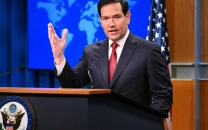The enigmatic Pakistan-US partnership
Pakistan & US represent typical dilemma of interaction between a superpower and a developing state.

The writer is an independent political and defence analyst. He is also the author of several books, monographs and articles on Pakistan and South Asian Affairs
The latest revival of Pakistan-US relations began after the terrorist attacks in the US on September 11, 2001. Pakistan abandoned the Taliban government in Kabul and joined the US-led global effort to fight terrorism. This reinvigoration of their relations has not been free from problems. Both sides have developed a host of complaints against each other over the last 13 years. If the sharp criticism of American policies towards this region has become an established practice in Pakistan, it is difficult to find any sympathetic discourse about Pakistan in the Washington-based think tanks and on Capitol Hill. It seems that the current level of official interaction between Pakistan and the US will become unsustainable after the US drawdown in Afghanistan and the end of the five-year funding under the Kerry-Lugar-Berman Law in 2015.
The US will have to address two interrelated questions in 2015-16. Can American interests in the region around Pakistan be served best by loosening ties with Pakistan and relying more on India, and Iran (post-nuclear settlement)? If the US wants to keep Pakistan on board for pursuing its goals in the region, how would it articulate a new relationship that satisfies Pakistan’s security concerns in the region and, at the same time, convinces the Washington-based official and non-official security and foreign policy elite about the continued relevance of Pakistan?
Pakistan also faces dilemmas in chartering its relations with the US in the post-2014 period. A good number of politically active people, including those in power at the federal level, think that Pakistan was dragged into the global effort to control terrorism by a dictator (Pervez Musharraf), which did not serve Pakistan’s interests. They also think that the Pakistani Taliban are angry because of Pakistan’s participation in American counterterrorism policy and that once American troops leave the region, it would be easy to win the Pakistani Taliban back into Pakistan’s Constitutional and legal fold.
The myth of making up with the Taliban will soon explode. The Nawaz Sharif government has hardly done any serious thinking for dealing with such a situation. It also shies away from talking about relations with the US from 2015 onwards.
The historic and current dilemmas in Pakistan’s relations with the US have been analysed in an easy-to-read and succinct manner in a recently published book entitled No Exit from Pakistan: America’s Tortured Relationship with Islamabad by Daniel S Markey (Cambridge University Press, 2013, 2014). It not only offers a critical appraisal of this difficult relationship but also addresses various aspects of Pakistan’s political and societal problems that influence Pakistan’s domestic and foreign policy choices. He offers three scenarios about Pakistan’s political trajectory (pages 65-71). Other important themes relating to the domestic context include Pakistan’s internal political and societal challenges projected as ‘Four Faces’, the nuclear-related concerns, the military and militancy, the strands of anti-Americanism, the political crisis in 2007, Benazir-Musharraf accommodation and the transition from Musharraf to the elected government.
Daniel Markey shares the views of other writers that relations between Pakistan and the US represent the typical dilemmas of interaction between a superpower with a global agenda and a developing state with local and regional interests. These interests do not always coincide, causing strains in their relations. Right from the beginning of the relationship in the mid-1950s, Pakistan and the US developed complaints against each other. Any change in the US’s global interests caused changes in its policies in South Asia.
He acknowledges that Pakistan’s political circles believe that the US viewed Pakistan ‘as a means to other ends’ like fighting communism, Soviet troops in Afghanistan or terrorism. “When Pakistan was helpful, it enjoyed generous American assistance and attention. When Pakistan was unhelpful, the spigot was turned off” (page 2). He rightly maintains that Pakistan also endeavoured to use the US to its advantage. It viewed this relationship “as a means to balance against India”. Consequently, the US and Pakistan failed to build this relationship to serve “beyond the immediate needs of the day” (page 3).
The book devotes attention to how Pakistan got on board for fighting terrorism in 2001 and the economic, military and diplomatic support that became available in the subsequent years. Whereas the contribution of Pakistan in arresting al Qaeda activists is acknowledged, the author talks about the divergences in their counterterrorism approaches, especially how to deal with various militant groups, the tribal areas and cross-border movement on the Pakistan-Afghanistan border.
The discussion of the most troubled year of bilateral relations — 2011—offers useful insights. The troubled incidents were: the Raymond Davis issue, the US military operation in Abbottabad to kill Osama bin Laden, Admiral Mullen’s anti-Pakistan tirade before his retirement, the US helicopter attack on Salala check post, and the suspension of American supplies to Afghanistan through Pakistan.
Markey offers three possible approaches to deal with Pakistan in the future: defensive insulation of Pakistan, military-first security cooperation and comprehensive cooperation. His preference is for combining the last two approaches because a complete cut-off and enforcing isolation of Pakistan is not viewed as a viable option. The analysis has a lot to offer to the policymakers of the two countries.
Pakistan and the US are difficult allies. If the relationship reflects the problems of stable relations between a developing country and a superpower, it also shows that a developing state can manoeuvre options within a specific political and geographic context. However, the long-term foreign policy options depend on a state’s internal political consolidation and economic resilience.
Published in The Express Tribune, June 3rd, 2014.
Like Opinion & Editorial on Facebook, follow @ETOpEd on Twitter to receive all updates on all our daily pieces.















COMMENTS
Comments are moderated and generally will be posted if they are on-topic and not abusive.
For more information, please see our Comments FAQ